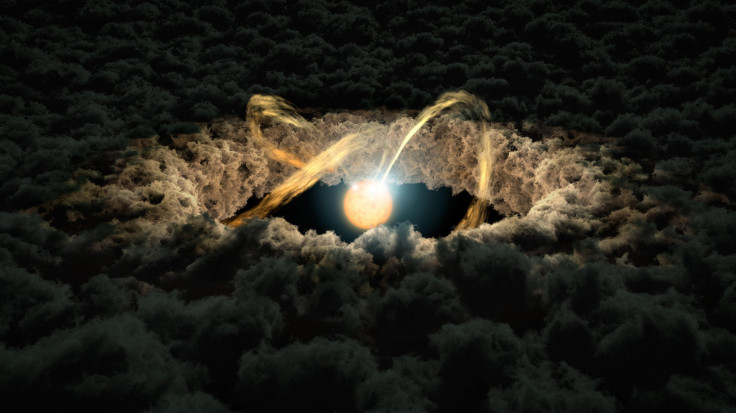How The Biggest Planets Form: Astronomer Has New Idea About Gas Giants

An astronomer has proposed a new model for how the most gigantic planets in the solar system grow into the massive balls of gas we know and love, and the idea could help scientists better understand our universe as a whole.
According to a paper in the Astrophysical Journal, giant gassy planets like Jupiter might form when ice and rock revolving around a young star clumps together, with the extreme heat of a primordial solar system evaporating the ice into gas and forming its atmosphere. As rocky material builds and builds, making the core larger and larger, the atmosphere becomes bigger and bigger as well.
“The formation of gas-giant planets like Jupiter is a central problem in planetary science,” planetary scientist John Chambers explains in his paper. And solving that problem could help scientists better understand more than just gas giants: “Understanding giant-planet formation is essential for understanding the origin and character of planetary systems in general, since gravitational perturbations from giant planets can affect the growth of objects elsewhere in the same system.”
An example is how the gravitational pull of Jupiter and Saturn, our solar system’s two gas giants, helped form the asteroid belt, the region of space rocks orbiting the sun at a distance between Mars and Jupiter and serving as the boundary between the inner and outer solar system.
Chambers’ framework differs from other models like the core accretion model, which dictates that the gas giants start as a solid core that, when it grows to a certain size, pulls in gas from the protoplanetary disk — the dense disk of gas and dust that rotates around a young star and contains the material from which the planets form. Rocky planets form in a similar fashion under this model, accumulating material from the disk, but they grow into a different type of full-fledged planet because they are closer to their stars and more heavily affected by the stellar wind, the charged particles that a star spews out toward its orbiting bodies.
Although the new concept is distinct from this core accretion model, a report on the research notes that it is not entirely new ground.
“It does conform to another theory that suggests that gas giants must form relatively quickly,” the report says.
According to that concept, because protoplanetary disks are generally found around young stars and gas giants need the huge amounts of hydrogen and helium found within them, these planets have to come together rather fast or they would not have time to gobble up enough of those elements that they need to form.
The new theory might offer some more insight into the interior of a gas giant. As the report points out, there has been some debate over exactly how concentrated Jupiter’s core is.
Just as it is with any planet in our solar system, it is difficult to look inside a gas giant. Various scientific measurements give us clues as to what is at their centers, but there is still much to learn about the planets and how they form and, at least in the case of Earth, how it developed into a place that could support life.
In addition to gaining more information about Jupiter, Saturn and our own solar system as a whole, better understanding gas giants could help astronomers who are studying other solar systems and alien planets. That includes the classification of exoplanets known as “hot Jupiters” — planets that are similar to Jupiter in size but are orbiting their stars much closer in, making their temperatures significantly higher.
It’s possible that there are many gas giants that orbit in outer regions of solar systems as well, but those have proven hard to detect. Exoplanets are generally observed when they pass in front of their stars from the viewpoint of Earth telescopes, known as a transit, a method that favors planets orbiting closer in.
© Copyright IBTimes 2024. All rights reserved.











